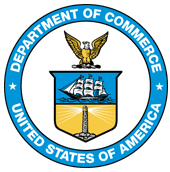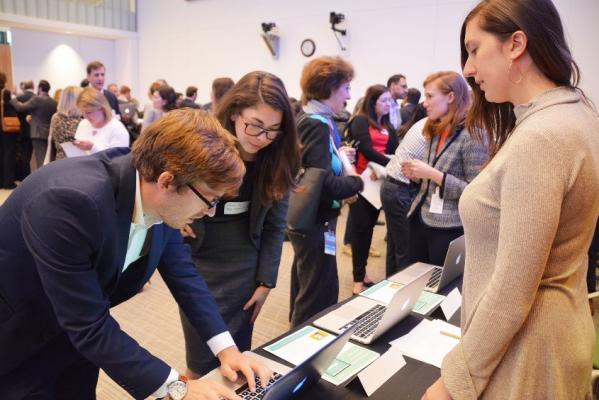Guest blog post by Drew Zachary and Mara Abrams, U.S. Census Bureau
On November 29th, Under Secretary for Economic Affairs Karen Dunn Kelley and Acting Census Bureau Director Ron Jarmin kicked off The Opportunity Project Demo Day, an event that brought together over 200 innovators from the tech industry, government, non-profits and universities to launch 12 new digital tools built with public data.
Launched in 2016 and led by Commerce since January, The Opportunity Project (TOP) is a pioneering model for public-private partnership. Through TOP, organizations collaborate to solve problems using data and technology in a 12-week user-centered design sprint. First, agencies like the Departments of Education, Commerce, Treasury and the Office of Management and Budget identify big issues facing the public, like youth and veteran homelessness, and engaging hard to count communities in the U.S. Census. Then, companies sign on to build tech solutions, and grassroots organizations help connect target end users to share their input. But that’s only the beginning – the tools continue to grow and serve their target end users even after the sprint ends. We’ve used this model to catalyze 50 solutions to date--built by teams like Redfin, Mapbox, Airbnb, LinkedIn and more, and we’re just getting started!
Here’s a round-up of new tools and resources launched by companies, non-profits, universities and the Department of Commerce at Demo Day.
- Cisco’s My City Data Learning Tool, MIT’s BayesDB, Measure of America’s DATA2GO.NYC and IBM’s PopCount (iOS app available in the App Store) help engage hard to count communities in the Census and help communities understand the value of Census Bureau data.
- Cisco DevNet also built a learning lab that helps their community of 400,000+ developers learn how to work and build with Census Bureau data.
- Care Partners Plus’s Get Vets Help and PAIRIN Pathways help homeless veterans access services and support, and military families find success in civilian careers. They also partnered with Lyft to make free rides available to homeless veterans in need of transit to critical services or job interviews.
- Excella’s Myspot helps youth experiencing homelessness find shelters, Wi-Fi hotspots and more.
- eCivis’s Grants Intelligence and True Impact’s Social Impact Reporting Platform help make federal grants data user-friendly for local leaders.
- Students from Ohio State launched their Opportunity Project Hackathon-winning tool Transity, which uses public and private data to provide daily commuters and city planners local “commutability” scores.
- 2016 TOP team Ovela came all the way from Estonia to share progress on FindYour.Town, which helps rural communities rebuild their economies by telling their unique stories and find available funding.
- The Census Bureau launched a User Centered Methods certificate program to build skills enterprise-wide in delivering on our mission using best practices of human-centered design.
- We launched The Opportunity Project digital toolkit so that anyone can adopt this process.
- The Census Bureau shared the latest of data.census.gov, a new platform for the public to interact and search the Census Bureau’s data, including new developer resources and APIs.
Big problems need cross-sector solutions. Although the tools presented at Demo Day were extremely diverse – ranging from IBM’s iOS app to MIT’s Artificial Intelligence-based system, to Cisco DevNet’s online game – what they all had in common was the incredible processes behind them. In their lightning talks, teams like Excella Consulting, PAIRIN, and IBM focused as much on their processes – which leveraged agile development, design thinking and human-centered design – as on the products themselves. And that’s really what Open Innovation is all about – reinventing government design as a collaborative process, not bound by the idea that government solutions have to be stuffy or out of touch – or that government has to be the only one designing solutions in the first place. TOP helps bring the design process and creativity of the tech industry to the table and helps us engage directly with the public to better understand their wants and needs. Government can identify big problems and available data, but people in communities know best what their experience is like day to day, and technologists know how to build effective digital solutions. Put all this expertise in a sprint together, and you’re going to get some amazing results. During Demo Day, Acting Federal CIO Margie Graves, Fiscal Assistant Secretary Dave Lebryk and Director of the Department of Education’s Policy and Program Studies Service Jenn Bell-Ellwanger echoed these ideas.
What’s next? This is only the beginning for TOP. Next year, we’ll be tackling problems like using geospatial data to advance community economic development, and our partners at Education, Treasury, OMB and more are just as excited to continue teaming up to solve new problems. Head over to opportunity.census.gov to view all the tools, join our next cohort, use our newly launched toolkit, help deploy the products built so far, share data feedback, or just stay in the loop! You can reach us at [email protected]. We hope these tools inspire you to join us in the next round, and we can’t wait to see what you build!


